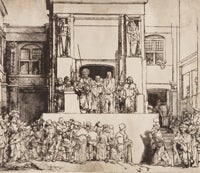Rembrandt and His School: Masterworks from the Frick and
Lugt Collections
February 15, 2011, through May 15, 2011
Partial Show Extension: Works on loan from the Lugt Collection will remain on view in the Lower-Level Exhibition Galleries through May 22. See a Virtual Tour of the paintings in the Oval Room.
Checklist of Henry Clay Frick's Prints
 |
|
Rembrandt van Rijn (1606–1669)
Christ Crucified between Two Thieves
(The Three Crosses)
by 1653
Drypoint and burin on vellum
State I of V
|
Rembrandt used both drypoint and an engraver's burin to produce this monumental depiction of Christ's crucifixion. He conveys the intensity of the stream of celestial light by rendering the figures in its path with spare contour lines and minimal detail. Their emotions are expressed instead through their demonstrative gestures as, for example, the particular tenderness with which Saint John the Evangelist supports the Virgin to the right of the cross. This impression is printed on vellum, which is less absorbent than paper and lends a matte quality to the ink.
 Return to top
Return to top
 |
|
Rembrandt van Rijn (1606–1669)
Landscape with Three Trees
1643
Etching, drypoint, and burin
Single state
|
Beneath a swirling sky and a magnificent Jacob's Ladder, rural life proceeds as usual: fishermen cast their lines at left, farm animals graze in the midground, lovers embrace in the underbrush at right, and an artist sketches in the open air above. In this etching, Rembrandt employs dense hatching over broad areas of the plate to convey the lushness of the landscape and to create the illusion of gleaming sunlight wherever the light-colored paper is allowed to show through.
 Return to top
Return to top
 |
|
Rembrandt van Rijn (1606–1669)
Christ Preaching (The Hundred Guilder Print)
c. 1643–49
Etching, drypoint, and burin on cream-colored Japanese
wove paper
State II of II |
 Return to top
Return to top
 |
|
Rembrandt van Rijn (1606–1669)
Christ Presented to the People (Ecce Homo)
by 1655
Drypoint on cream-colored Asiatic wove paper
State II of VIII
|
The technique of drypoint, by which an artist scratches directly into the metal plate producing a line with a raised burr of metal alongside it, is often used to enhance an etching with the rich, hazy line the burr produces upon printing. Here, Rembrandt creates his entire image with the drypoint needle. In this especially fine, rich impression, all the subtleties of human expression are as vivid as the artist intended. The sheet bears a handprint at upper right — probably Rembrandt's own.
 Return to top
Return to top
 |
|
Rembrandt van Rijn (1606–1669)
St. Francis Praying beneath a Tree
1657
Drypoint, etching, and burin with plate tone
State II of II |
 Return to top
Return to top
|
 |
|
Rembrandt van Rijn (1606–1669)
Clement de Jonghe
1651
Etching
State I of VI |
 Return to top
Return to top
 |
|
Rembrandt van Rijn (1606–1669)
Jan Lutma the Elder
1656
Etching and drypoint
State II of III
|
 Return to top
Return to top
 |
|
Rembrandt van Rijn (1606–1669)
Cottage with a White Paling
1648?
Etching
State I of III
|
 Return to top
Return to top
 |
|
Rembrandt van Rijn (1606–1669)
The Goldweigher's Field
1651
Etching and drypoint
Single state
|
 Return to top
Return to top
 |
|
Rembrandt van Rijn (1606–1669)
Landscape with Three Gabled Cottages
1650
Etching and drypoint with plate tone
State III of III
|
 Return to top
Return to top
Principal funding for the exhibition is provided by The Christian Humann Foundation, Jean-Marie and Elizabeth Eveillard, and Melvin R. Seiden.
Corporate support is provided by Fiduciary Trust Company International.
The exhibition is also supported by an indemnity from the Federal Council on the Arts and the Humanities.
The catalogue is made possible by the Robert Lehman Foundation, Inc. It is also underwritten, in part, by public funds from the Netherlands Cultural Services and by the Netherland-America Foundation. |


